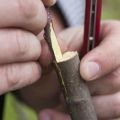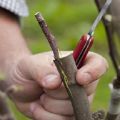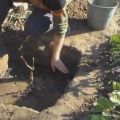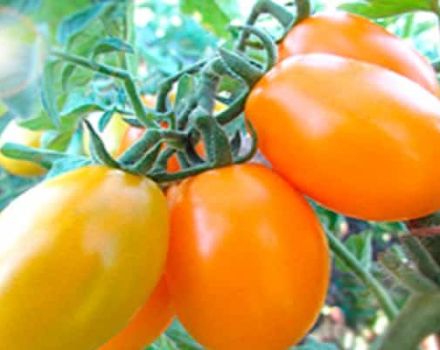How to properly plant grapes on an old bush with green cuttings in spring, summer and autumn
Many experienced growers consider grafting grapes as the best way to improve their properties. Carrying out such a procedure rejuvenates the bushes, improves the taste of a ripe crop and even enhances protection against common pests and diseases. Before starting the vaccination, you should familiarize yourself with its description and features of the conduct.
What is the vaccine for?
Some gardeners don't know why they are grafting plants. Therefore, it is recommended to figure out in advance why such a procedure is being carried out. Grafting is used to:
- Strengthen the stems. After grafting, the plant stems are strengthened by increasing their diameter.
- Adapt to new conditions. The grafted bushes quickly get used to the soil in which they grow and to the weather conditions.
- Give certain properties to grape seedlings. These include immunity to most insects and diseases, earlier ripening of fruits, accelerated growth.
- Form the most suitable growth shape. Vaccination allows gardeners to independently give the bushes one form or another.
- Grow several different grape varieties at once. This saves space in the garden.
- Renew cultivated varieties. The peculiarities of the procedure allow you to renew old or diseased grapes by grafting.
Basic rules of vaccination
Grafting is considered a difficult procedure that many inexperienced growers cannot handle. If you do not know how to do this correctly, you can damage the bushes, because of which they will die.
Therefore, it is better to familiarize yourself in advance with the basic rules of vaccination and figure out what you should pay attention to.
The basic rules that will help to carry out the procedure successfully include the following:
- when grafting grapes, methods are used green to green or black to black;
- in order for the scion to take root well, use only the most suitable grape varieties for certain climatic conditions;
- for grafting, a scion with resistance to pests and diseases is selected;
- the growth rate and ripening time of fruits in the scion and rootstock should not be different;
- if grafting in a stem is carried out in spring or late winter, then the scion will have to be harvested in early autumn;
- when carrying out the procedure in the summer, they use recently cut branches;
- to cut the scion, use a knife disinfected in an alcohol or manganese solution;
- when trimming cuttings, the knife blade is directed away from you so that the cut does not turn out to be concave;
- vaccination should be done when the temperature is more than 15-17 degrees Celsius.
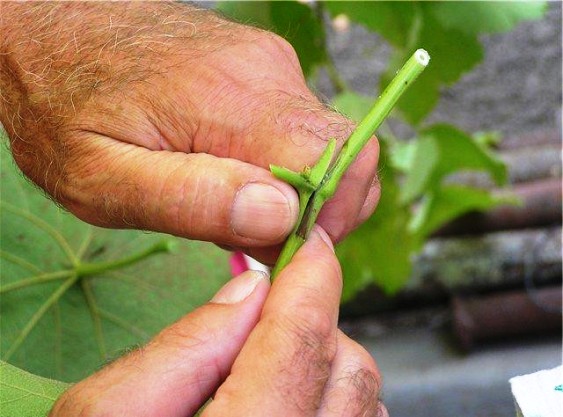
What tools and materials are needed for vaccination?
Grafting begins with the selection and preliminary preparation of special tools. Choosing the right tools should be taken seriously. If they are not sharp enough, the scion or rootstock can be damaged.
To complete the procedure, you will definitely need a knife. There are several types of knives that you can use:
- Garden. Such a tool is ideal for cutting the stems and unclogging the cut.
- Oculating. It is used when carrying out budding with the help of the kidney. The features of such a knife include the concave shape of its blade, which makes it easier to trim the bark.
- Copulation. It is considered the best knife for grafting plants by grafting. The copulating tool has a perfectly straight blade, with which it is possible to make straight cuts.
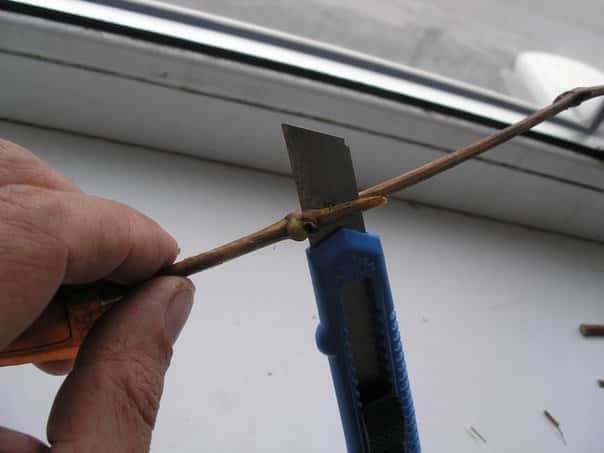
In addition to a knife, they use a grafting pruner, which is needed to cut the stems of grapes. The procedure can be carried out with the following types of secateurs:
- Standard. Most often, it is he who is used when cutting grape branches, since it does not damage their surface and makes even cuts. The distinctive features of standard models include the fact that their lower blade is slightly offset.
- Anvil. These tools do not have offset blades and are therefore not easy to cut thick branches. Gardeners advise using an anvil pruner only for cutting off dried old twigs.
- With ratchet mechanism. This is a versatile model ideal for pruning dead and young branches. Due to the ratchet mechanism of the tool, cutting the stems requires little effort.
Harvesting cuttings
Before grafting, they are engaged in preliminary harvesting of cuttings. It is recommended to do this in early autumn, before the first night frost. Cuttings cut in winter or the second half of autumn are not suitable for grafting.
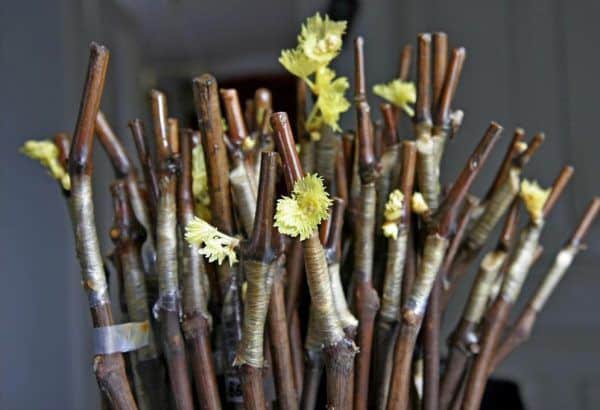
When preparing, you must adhere to the following recommendations:
- Cuttings are cut with pruning shears only from healthy bushes that bear fruit well. At the same time, you cannot cut them off from the top of the shoots, since such branches will not take root well. Therefore, a part of a healthy shoot is cut off at a distance of about 30-40 cm. It is also important that the cut branches do not have mechanical damage and are not too thin.
- A sharpened pruner or knife is used to cut the branches. The length of the cut cutting should be 10-12 cm.
- If you cut the twig unevenly, then in the future it will not take root. Therefore, it is recommended to practice a little on old branches before harvesting. When pruning, make an incision 5-6 mm deep and then carefully insert the knife blade to the end of the branch so that the cut is even.
- The cuttings are placed in a large container filled with copper sulfate. This is done to disinfect the cut site.
Grafting in spring
Some gardeners are engaged in grafting grapes in the spring. The procedure should be carried out in mid-April, when the soil warms up to 10-12 degrees.
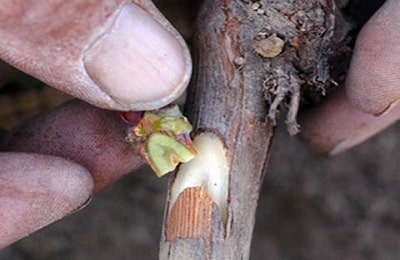
Budding
When budding is carried out, you will have to cut off a small shield on the stem. Then a cut is made on the rootstock with the same dimensions so that the scion can be combined with the rootstock. After crossing the branches, the place of their connection is carefully wrapped with a plaster.
Cleft grafting
The method of grafting grapes in the split is considered the simplest and most common among winegrowers. For the procedure, you will have to select in advance the blackest and thickest branch from which a 6-7 cm long stalk is cut.Then a 2-4 cm deep incision is made on the rootstock, to which a cut off branch is applied. The junction of the branches is carefully wrapped with a tourniquet.
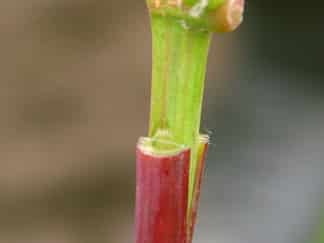
Split grafting into an underground shaft
A few days before grafting grapes, the harvested stems are placed in a solution made from "Epin". Then the trunk of the plant, to which the stems will be grafted, is dug in to a depth of 15-20 cm.After that, the roots that are on the surface of the soil are cut off, and a 3-5 cm long incision is made in the center of the trunk. A scion is inserted into the created incision, after which it is lubricated clay and wrapped in cloth.
Drill grafting
Before grafting, the drill is disinfected in a solution of manganese for half an hour, after which a hole is drilled in the grape trunk. Its depth should be about 5 cm. Then a handle is inserted into the drilled hole and the joint area is carefully lubricated with clay.

Autumn grafting
Grafting of grapes on an old bush is most often done in the autumn. By crossing young stems with old bushes, they increase the level of fruiting of the plant, thanks to which a tasty harvest can be obtained within a year. Grafting of grapes in the fall is carried out in early September, when the summer heat subsides. In this case, you will have to monitor the minimum daytime temperature. If it falls below 15 degrees, the scion will not take root.
First, the thickest stems are cut from the old bush. To do this, use a sharp pruner or saw if the branches are too large. All sections must be treated with a manganese solution to disinfect them.
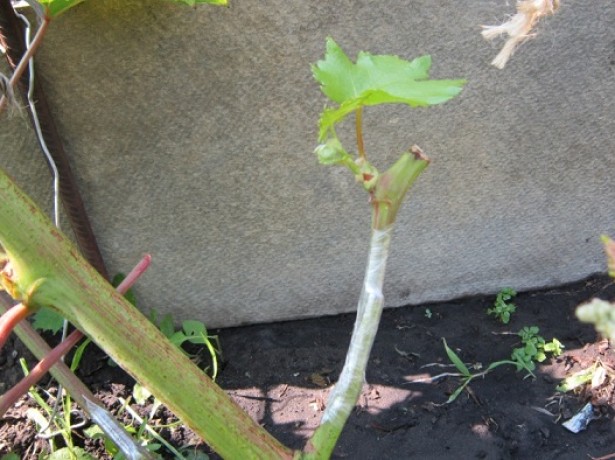
After pruning the old bushes, they begin to prepare the cuttings. They are treated with a liquid to improve growth and soaked in water for 2-3 days. When more than three swollen buds appear on them, they are carefully inserted into the prepared incision on the stem of an old grape bush. Then the junction is filled with sawdust and tied with a tourniquet. Some gardeners wrap it with plastic oilcloth.
Summer vaccination
Grafting is carried out in summer with green cuttings or black grapes. In the latter case, twigs harvested in the autumn are used. They are soaked in water in advance to speed up the swelling of young buds.
August is great for grafting. Some growers perform the procedure in July. During grafting, the scion is carefully trimmed at an acute angle. Then a split is made in the largest stem of the stock, into which a grape branch is inserted. It is carefully wrapped with twine and wrapped in a film.
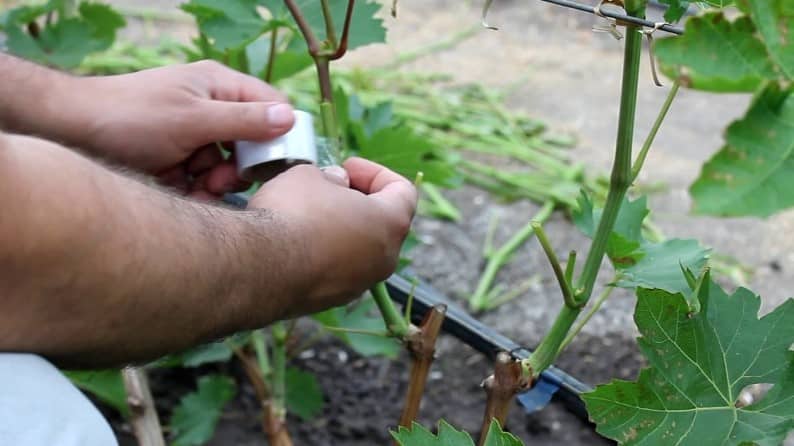
Sleeping bud budding
Many consider this method of budding the most reliable, since the survival rate of plants is about 90%. To vaccinate, it is enough to prepare one grape bud. It is cut from the ripe branch itself, and it is cut along with a piece of wood and bark. The cut kidneys are wrapped in a damp cloth and soaked for 3-4 hours. Then an incision is made on the surface of the rootstock bark, into which the prepared bud is placed.
The area with the cut is carefully lubricated with plasticine, which is necessary to retain moisture.
Winter grafting
Inoculation in the winter is most often used for crossing bushes over two years old. This is done in the last week of February or in the first half of March, when the frost is weakening. Some also plant young seedlings in pots in winter. In this case, you will have to vaccinate at the end of December.

They have been preparing the bushes since the fall. In October, they are dug up and trimmed so that the length of the trunk does not exceed ten centimeters. Then the dug out seedlings are sprinkled with sawdust, treated with a manganese solution and transferred to the basement.3-4 days before the procedure, they are placed in a container with warm water for two days and grafted into the cleft.
The grafted plants stand for about a month in a room with a temperature of at least 20 degrees. During this time, you will have to make sure that new shoots do not grow on them. It will be possible to plant grape seedlings in the garden when the temperature outside is about 17 degrees Celsius.
Vaccination care
It is necessary to properly care for the vaccine so that it takes root well. You should familiarize yourself with the peculiarities of caring for the grafted vine in advance so that it does not deteriorate and does not have to be re-grafted. There are several rules that will help when caring for grapes:
- The place of the scion should be tightly wrapped with a cloth or any other material. If juice seeps out of the junction of the branch and trunk, you will have to rewind the plant.
- 2-3 times a week, check whether the grafted twig takes root. There are times when the stems do not grow together well and you have to re-cross them.
- For two weeks, the bush is treated with potassium permanganate or Bordeaux liquid. It is useful for warding off disease and stimulating fruiting.
- If the procedure was carried out in the autumn, the base of the bush is periodically covered with sawdust or straw. This shelter protects him from low temperatures.
Conclusion
Many growers are engaged in grafting grapes in order to cross different varieties with each other. Before doing this, you will have to familiarize yourself with the main nuances of the procedure, the tools that will be needed to carry it out, and the care of the grafted vine.


